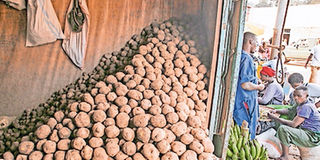Potato project to unlock potential of crop in the Rift

To produce a good potato crop, one acre farm requires an investment of between Sh60,000 to Sh80,000 per season of three to four months depending on the maturity time of the variety grown. FILE PHOTO | NMG
What you need to know:
- It is estimated that the crop is grown by 600,000 to 800,000 farmers with a total production of 1 to 1.4 million tonnes worth Sh30 to Sh40 billion per year (Technoserve, 2018).
- To produce a good potato crop, one acre farm requires an investment of between Sh60,000 to Sh80,000 per season of three to four months depending on the maturity time of the variety grown.
- The project’s goal is to transform the potato value chain in Nakuru into a vibrant commercialised sub-sector for improved income and livelihoods of smallholder farmers.
Nakuru County government in partnership with the National Potato Council of Kenya, Egerton University, and Baraka Agricultural Training College will hold the South Rift Region Potato Fair on August 31 at Baraka Agricultural Training College in Molo.
The event will seek to unlock the potential of potato farming in the county. The Irish potato (Solanum tuberosum) is the second most important food crop in Kenya, after maize. The tuber can be used in making stew, mukimo, fried chips, crisps and other meals.
It is estimated that the crop is grown by 600,000 to 800,000 farmers with a total production of 1 to 1.4 million tonnes worth Sh30 to Sh40 billion per year (Technoserve, 2018).
The productivity of potato tubers ranges from between 8 and 10 tonnes per hectare, depending on agricultural practices and agro-ecological zone grown (within the recommended 1,500 to 3,000m above sea level).
It is possible to more than double the productivity by using good agricultural practices that include the growing of certified seed potato.
In Nakuru, there are about 20,000 farmers growing potatoes on 38,000 acres with a total production of 160,000 tonnes of assorted varieties being grown with shangi dominating.
To produce a good potato crop, one acre farm requires an investment of between Sh60,000 to Sh80,000 per season of three to four months depending on the maturity time of the variety grown.
With seasonal fluctuating prices ranging from Sh20 to Sh60 per kilo, a tuber yield of three to four tonnes per acre (8—10 t/ha) would give the farmers an income of Sh60,000 (for Sh20 per kilo) to Sh180,000 (for Sh60 per kilo) of the lower (3 t/ac) yielding crop and Sh80,000 to Sh240,000 respectively of the higher (4 t/ac) yielding crop.
This means that profitability of potato production can go for up to Sh180,000 per acre over a four-month period. With the potential of growing potatoes two to three times a year in Kenya, it is possible for farmers to earn an average Sh90,000 per season net profit or Sh180,000 per year from two seasons.
In a conservative agribusiness scenario, where there is a sure market offering Sh35 per kilo for a 3.5 t/ac yield, farmers are sure to get gross profit of Sh100,000 making a net profit of Sh40,000.
The potato fair is part of Egerton University’s project dubbed Community Action Research Approach Project (Seed Potato CARP+) along with the Baraka Agricultural College, Molo, the Nakuru County government, Ministry of Agriculture and the potato council to boost production of the crop.
The project’s goal is to transform the potato value chain in Nakuru into a vibrant commercialised sub-sector for improved income and livelihoods of smallholder farmers.
The difficulty of accessing high quality seed potato will be tackled by introducing the Viazi Soko mobile application.
This is a SMS and online based platform developed by potato council to enable farmers query and get information on availability of certified seed as well as market ware potatoes. The platform is also used to disseminate potato related information to farmers.
With these interventions, it is expected that farmers will more than double their yields and incomes through adoption of good agricultural practices and postharvest management technologies.
Article by Prof Anthony M. Kibe and Dr Mariam Mwangi (Department of Crops, Horticulture and Soils, Egerton University) and Wachira Kaguongo and Esther Kaguora of the National




